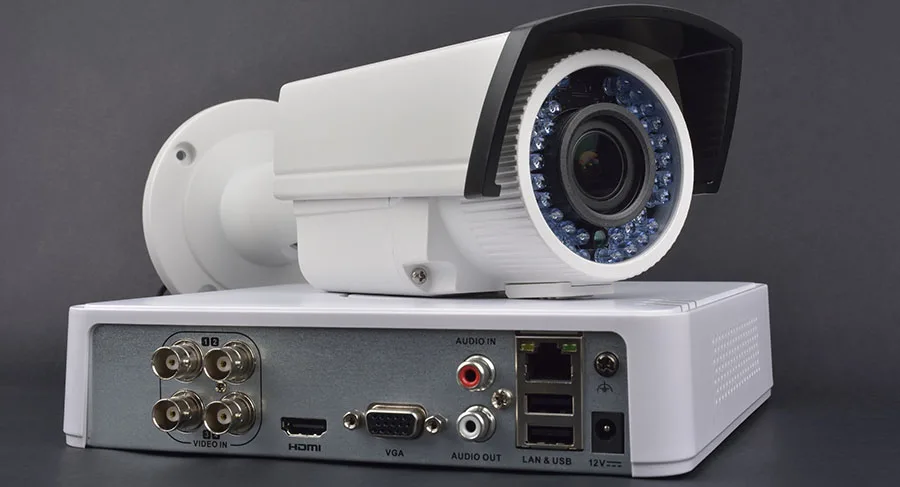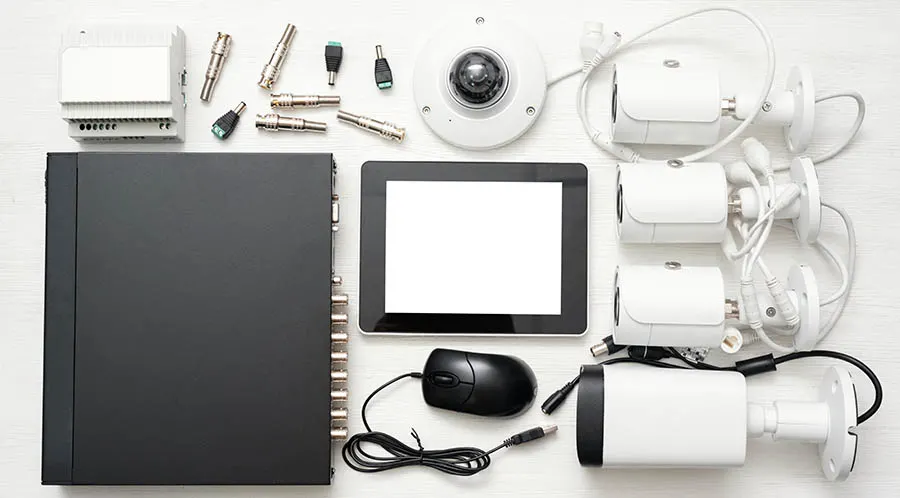All security cameras may serve the same purpose, but you need to understand the differences in camera types before setting up a system. If you don’t, you could be setting yourself up for complications down the road. Recognize that not every security camera has universal compatibility with other systems; read on to find out more.
Not all security cameras are compatible with all DVR systems. DVR systems use analog BNC connections to transfer video from the camera. Digital/IP cameras will need modification to work with DVRs, or they’ll need to be used with an NVR system.
Understanding the difference between the two main types of security systems, DVR or NVR, will help you determine what kinds of cameras you can use. Each system works with its method of video encoding and can not easily be used interchangeably. To make an analog or IP camera work on the opposite system often requires special equipment like a PoE Switch, or conversion of its connectors (more on PoE safety in our guide)
NVRs vs. DVRs, an Overview

NVR stands for Network Video Recorder. They are systems that use IP based cameras and your local network to transfer video and audio to the central NVR unit. NVR can offer features and benefits that DVRs cannot. A DVR, or Digital Video Recorder, uses analog cameras instead of network-based IP cameras. Both devices use software installed on the central unit to manage your video feed. Most will have onboard storage as well.
The main difference between the two types of systems is how they convert the video signal. For DVR based systems, a video capture card is installed in the central unit. This allows for the analog signal coming from the cameras to be processed into a digital format. The thing to note here is that the video feed comes from the camera and travels down the RG59 coaxial cable as an analog signal until it gets converted at the DVR. This digital feed can now be sent out over connections like HDMI or VGA.
NVR systems tackle this process differently. Instead of converting the signal at the central unit, the video is converted at the camera itself. This allows the digital stream to be sent out either via hardwired ethernet cables or over the network wirelessly.
DVR systems, and analog cameras, use RG59 coaxial cable instead of Cat5/Cat6 ethernet cable. This wire consists of a solid copper core surrounded by protective shielding to transfer the data. With coaxial cable, the only thing that can be transferred is the analog video feed. To transfer power or audio requires additional wiring.
NVRs vs. DVRs, Key Differences
Here are some of the main differences between the two types of systems:
- NVR systems use your network to transfer video and audio. Unlike analog systems, this network can go down, disrupting the video feed. In contrast, DVR systems aren’t able to take advantage of wireless functionality for this reason. Analog cameras require a hard-wired connection. But those connections may be more secure than ethernet connections.
- Most DVR systems cannot transfer audio. To do this requires an additional RCA connection. NVR systems, because they use ethernet cables, can transfer video and audio over a single line. Some NVR are PoE, power over ethernet enabled, and can even transfer power over the same cable.
- NVR can be more expensive. With the additional features of NVR systems, the IP cameras they require can cost more than traditional DVR analog systems. This has to do with the fact that IP cameras convert video signals in the camera before sending it off. This requires more hardware and adds to the price.
- NVR systems tend to offer better video quality. This gap in image quality, however, is changing as DVR systems catch up to their digital counterparts.
- DVR systems are less prone to interference. This is due to the type of cable being used. The RG59 cable used in DVR systems includes several layers of shielding that can prevent electrical interference. There are ethernet cables that can offer this same type of protection, but only if you look for it. Standard Cat5 cables don’t provide this extra shielding.
Always consider your security needs when assessing your system. While both NVR and DVR systems offer different benefits, the main difference is the types of cameras being used. Understanding this can help to determine if the cameras you have will work with your system.
Using the Correct Cameras With Your DVR

When using analog cameras, the device setup should be relatively simple if you are using a DVR system. Cameras like the Cumcitin IR Security Dome Camera (on Amazon) come out of the box with the connections you need to plug in to get things working. Depending on how your camera gets power, you might be working with just an RG59 cable with BNC connectors or Siamese Cable (on Amazon), a combination of the RG59 and a power cable.
Like the one featured above, some cameras will also have an RCA audio cable that will need to be run if you want audio functionality. These cables use BNC connectors that are very similar to the ones used on the back of TV sets.
Using analog cameras is a simple process if you are using a DVR, because they are designed to work with each other. If you are trying to source cameras for your DVR system, always look for the term ‘analog’. This will confirm you have the right cameras for your system. If you have IP cameras, you will not have such an easy experience.
IP cameras, or internet protocol, are designed to be used by an NVR system. Just like DVR, these systems are designed to work with each other using specific connections. In this case, NVR uses ethernet cable and RJ45 connectors.
Look for terms like IP or PoE if you are wondering if your cameras will work with your DVR system. Without the proper connections on your DVR, you will need to find a workaround if you want to use a camera like the Amcrest UltraHD, which you can find (on Amazon) for a good price .
Making a DVR Work with IP Cameras
Depending on your hardware, you might be able to use a PoE Ethernet Switch (on Amazon) to create a bridge between your DVR, your IP cameras, and your router. Once you have these connections established, you should access the IP cameras streams through your DVR software. Some systems only offer limited support for these types of functions. Consult your DVR’s owner’s manual to determine this information.
When working with IP cameras, you may also come across problems with ONVIF compatibility. ONVIF is a proposed standard for IP security cameras; this results from compatibility issues between cameras and systems made by different manufacturers. Consult your camera’s documentation to find this information. If your camera is ONVIF compatible, it will usually be advertised information.
Working with Analog Cameras
One of the main draws is analog cameras can help build a more customized system. Any cable that carries power has length limitations of around 300ft, and PoE ethernet is no exception. RG59 cables start to show data loss at about 750ft. As long as you have access to power near where the camera is placed, you can have cameras farther away than if you used an IP-based system.
There are even video amplifiers, like the 1080p amplifier from WSQIWNI which you can find here (on Amazon), that can extend this length to over 3000ft.
